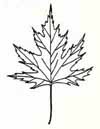

Unfortunately, many of us are stuck with silver maples
in our landscapes that were planted by an earlier owner.
They have been planted for decades because they grow
fast and give you shade in a relatively short number of
years. However, one of the key laws of horticulture is
that fast growing trees make weak wood. This
means they are messy, break apart in ice and wind storms
and cause a lot of maintenance problems.
Silver maples also develop very shallow roots which
will lift sidewalks and cause your lawn mower to bump
around. If planted too near the sewer pipe, they will
invade and cause backups in the house. They produce
copious amounts of seeds which can clog drains and
eavestroughs with seedlings. The fall color is usually a
pale yellow and nothing to write home about.
Finally, silver maples have a lot of health problems
too. Annoying bumps called galls often cause the leaves
to look like something from outer space. The soft bark
is easily broken and invaded by organisms that cause
open wounds called cankers. These will cause branches to
die and need to be pruned off.
Silver
maple is most appreciated for its rapid growth and
tolerance of soils, though as it grows older it creates
problems. It is weak-wooded and large trees often
suffer storm damage. Damage is also caused by insects
and disease. In addition, the root system is
invasive-clogging pipes and buckling sidewalks and
many seedlings appear each year and create weeds.
Now what was there to recommend this species? Oh,
yeah, it grows fast...but you will regret it for a very
long time. Be very careful before you consider planting
one of these in your home landscape! |

